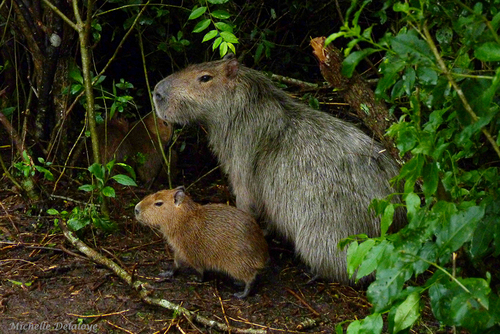
Capybara
The capybara, Hydrochoerus hydrochaeris, thrives in South America's wetlands, showcasing its superb swimming skills and social nature. As the largest rodent, it plays a vital role in its ecosystem, primarily grazing on grasses and aquatic plants, and is easily identified by its webbed feet and stout, furry body.
8-10 years
Lifespan
30.0 - 70.0 kg
Weight
Length: 1.0 - 1.3 m
Size
Brown, Grey, Yellow, Red
Color
17-19 months
Age of Sexual Maturity
16 weeks
Age of Weaning
22 mph
Top Speed
Least Concern
Conservation Status
Stable
Population Trend
Characteristics
Hydrochoerus hydrochaeris, commonly known as the capybara, is the world's largest rodent, native to South America's wetlands, riverbanks, and forests. They are highly social animals, often found in groups, and are excellent swimmers, using water as a refuge from predators. Capybaras have webbed feet, a barrel-shaped body, and a distinctive short, dense coat.
Distribution Range of the Capybara
Hydrochoerus hydrochaeris, commonly known as the capybara, is native to South America. Its geographical distribution includes countries such as Brazil, Venezuela, Colombia, Argentina, Uruguay, Peru, Paraguay, and Bolivia. It is also found in the eastern parts of the Andes.
Capybara's Habitat
Environmental Conditions
Capybaras inhabit regions with abundant water sources. They are typically found in savannas, dense forests, and wetlands, often near rivers, lakes, and marshes. The regions they inhabit generally have a tropical to subtropical climate, characterized by warm temperatures and seasonal rainfall.
Ecological Niche
Capybaras are semi-aquatic mammals, well-adapted to both land and water environments. They play a crucial role in their ecosystem as grazers, feeding on a variety of grasses and aquatic plants. Their presence influences the vegetation structure and provides a food source for predators. Capybaras are also known for their social behavior, often living in groups that can help in predator avoidance and resource sharing.
Copyright @ Nature Style Limited. All Rights Reserved.
 English
English